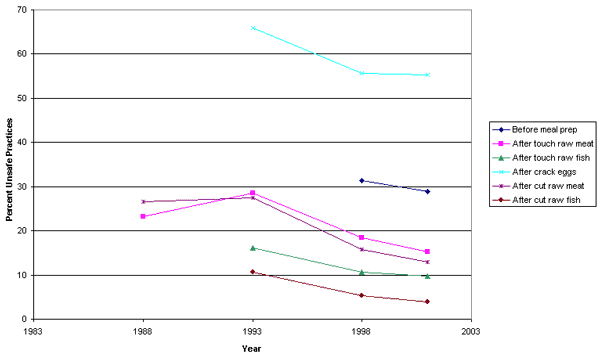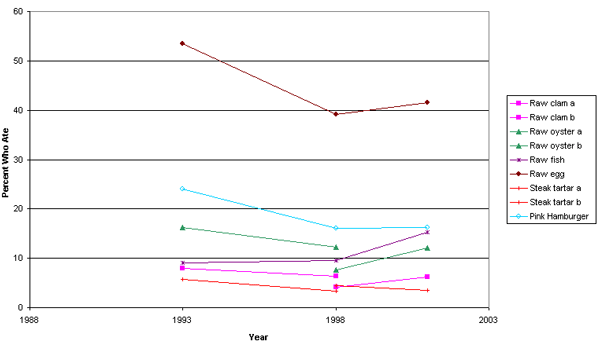|
Chart 1: FDA/FSIS Food Safety Survey. Cross-Contamination Measures: 
|
The Food Safety Survey (FSS) is a random digit-dial survey of a nationally representative sample of American consumers conducted by the Food and Drug Administration. Data were collected in 1988, 1993, 1998, and 2001, with sample sizes 3,200; 1,620; 2,001; and 4,482. The FSS obtains information that FDA uses for risk assessments, regulatory and policy matters, and consumer education purposes.
The trend data describe food safety practices related to cross contamination and to consumption of potentially risky food. We ask how consumers clean their hands and cutting surfaces after touching or cutting raw fish and meat and chicken. We also ask whether people eat several different raw or undercooked foods from animals, including pink hamburgers, steak tartar, and raw oysters, clams, fish, and eggs. By 2001, a portion of some of these foods in the market had received post harvest treatment or had been produced under programs designed to decrease the risk of contamination with pathogens. However, especially because consumers may not know the status of foods they ate raw or undercooked, we have no questions that distinguish treated from untreated raw foods.
In 1998, the questions on food consumption were asked in two different ways. Half the sample was asked the food consumption questions with exactly the same wording as in 1993. The other half sample replied to questions that asked about consumption in a more precisely defined time period. In 2001, all respondents were asked about potentially risky food consumption in the more precisely defined time period. Because of the wording change, two estimates are reported for certain questions from the 1998 data, one to compare with 1993 data and the other to compare with 2001 data.
The trends for both cross contamination measures and eating potentially risky foods are very similar. In 1988, we did not ask all of the trend questions. When we have 1988 measures, no improvement occurs between 1988 and 1993, and for one measure (washing hands after touching raw meat or chicken), the safety of the behavior becomes worse. Between 1993 and 1998, we find significant improvement on all of the measures of cross contamination and on four of the six measures of eating potentially risky food. Then, between 1998 and 2001, most of the measures of cross contamination show additional but small improvement, which is an achievement after such a dramatic change. However, while some of the measures of eating potentially risky foods show no change between 1998 and 2001, others show an increase in unsafe consumption. In particular, the gains remain for not eating steak tartar, pink hamburgers, and raw eggs, but consumption increases for raw clams, oysters, and fish.
In all of the time periods, people have safer behaviors with respect to some foods, indicating a differing relative perceived risk for various foods. In particular, the pattern is that behaviors regarding fish have the safest levels, behaviors with meat and chicken are the next safest, and behaviors with eggs are the least safe. For example, in 1993, 16% of people did not wash their hands after handling raw fish, 28.5% did not wash hands after touching raw meat or chicken, and 66% did not wash hands after cracking raw eggs. These numbers have the same pattern in 2001: 10% for fish, 15% for meat and chicken, and 55% for eggs. Similarly the percent of respondents who ate the product raw or undercooked in 1993 was 9% (raw fish); 6% (steak tartar); 24% (pink hamburgers), and 53% (raw egg), and the order was the same in 1998 and 2001. The pattern of relative unsafe behavior with respect to eating particular foods changes in 2001, when the percent of population who eat raw fish (15%) is not significantly different from those who eat pink hamburgers (16%).
In summary, after years of no change or slight worsening, large improvements in food safety practices were seen between 1993 and 1998 (as measured by cross contamination behaviors and consumption of risky foods). These gains were maintained between 1998 and 2001 for cross contamination and for consumption except for raw seafood.
Sara Fein, Ph.D. , Alan Levy, Ph.D., and Amy Lando
Consumer Studies Team
August 27, 2002
|
Chart 1: FDA/FSIS Food Safety Survey. Cross-Contamination Measures: 
|
|
Chart 2: FDA/FSIS Food Safety Survey. Eating Potentially Risky Foods: 
|
Chart One is entitled "FDA/FSIS Food Safety Survey. Cross-Contamination Measures: Percent of U.S. Population Who do Not Wash Hands or Cutting Boards." It is a line chart with the Percent of the US Population who engages in the unsafe behavior on the Y-axis and the years the data was collected on the X-axis. Data are shown for four years: 1988, 1993, 1998, and 2001. Some of the measures do not have data points.
All changes between 1993 and 1998 are statistically significant. All changes between 1998 and 2001 are also statistically significant except hand washing after cracking raw eggs and after touching raw fish.
Chart two is entitled, "FDA/FSIS Food Safety Survey. Eating Potentially Risky Foods: Percent of US Population Who Ate Each Food." It is a line chart with the percent of people who reported eating each potentially risky food on the Y-axis and the Year on the X-axis. There are three years of data for each measure: 1993, 1998, and 2001. For three of the foods, raw clams, raw oysters, and steak tartar, there are two numbers reported for 1998. This is because the word ings of these questions changed between 1993 and 2001 and were asked both ways in 1998. "A" after the food name is the 1993-1998 comparison; "b" is the 1998-2001 comparison.
There was a statistically significant change between 1998 and 2001 for fish, clams, and oysters.